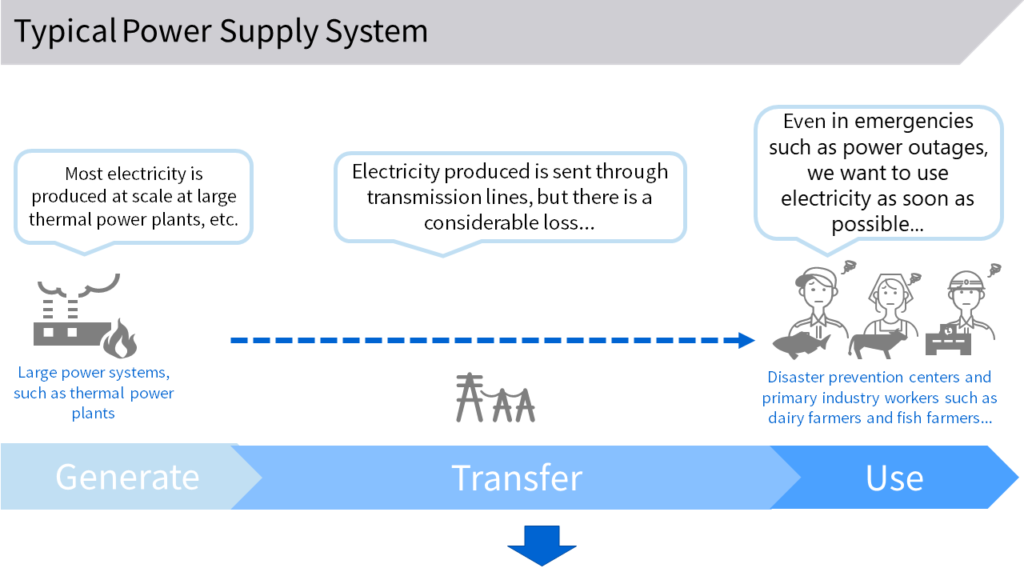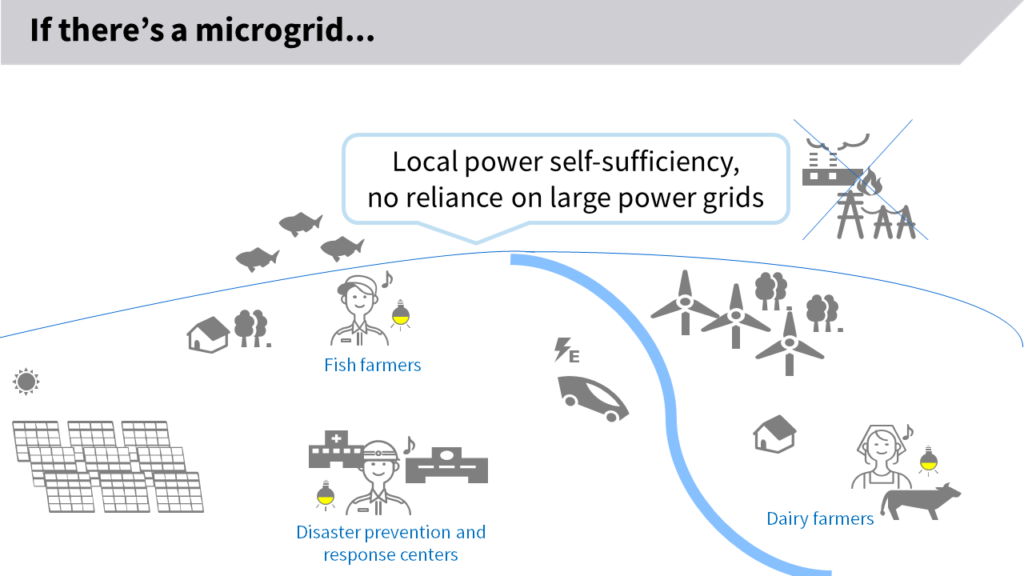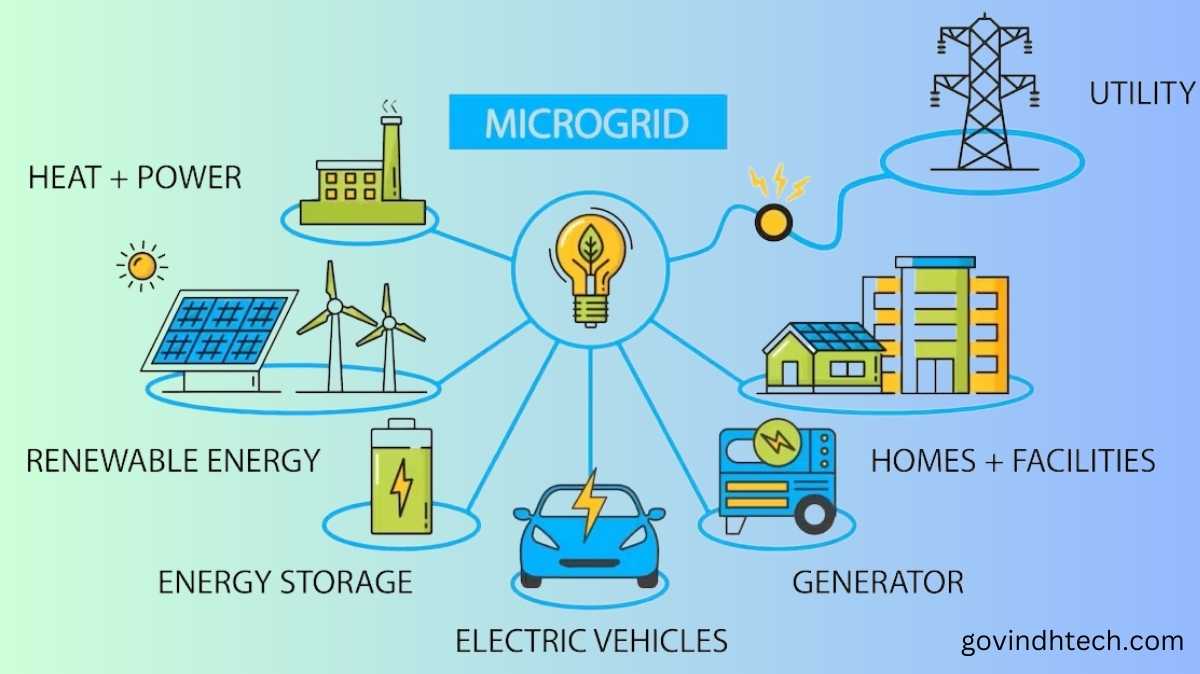A Hidden Force Maintaining Local Power Grids Microgrid Evaluation Technology
- Renewable energy adoption requires local microgrids.
- World-first evaluation method to advance microgrids
- Can electric power use a low-cost mobile service provider model?
Countries must urgently adopt solar power and other renewable energy sources to reach carbon neutrality. The microgrid, a small power grid, is key. Microgrids enable “local production for local consumption of electricity,” and they are being considered as a disaster power source. Toshiba successfully demonstrated a microgrid-stabilizing technology for the first time in the world. Here, we examine the details.
Successful world-first demonstration experiment
Toshiba Research and Development Center’s Dr. Tetsu Shijo says, “This was the world’s first demonstration experiment of a GFM inverter.” It provides a solid foundation for microgrid evaluation criteria. To understand this breakthrough, we must understand GFM inverters, the difference between a large generator and a microgrid, and the future challenges. Shijo enjoys explaining these details.
Grid forming (GFM) involves building and stabilizing the electricity flow system to maintain balance in this integrated power generation, transformation, transmission, and distribution system. A GFM inverter regulates electricity frequency and voltage to stabilize the grid.
GFM inverters have been proven theoretically effective, but nobody has connected one to a power system. Our demonstration results at an industry conference surprised people, and we got many questions about the details.”
Toshiba is proud of its longstanding commitment to energy supply and ensuring plants operate as planned. Toshiba plays that role, too, says Shijo. What challenges did the GFM inverter project face to complete the world’s first demonstration experiment? We can evaluate the project in light of microgrids.
All about microgrids
Most of us get electricity from big power plants. However, disasters can cause long-term outages on remote islands and other hard-to-supply areas. Microgrids, which generate and consume electricity locally, are highlighted here.
Disaster prevention and response centers, water and sewage systems, factories, and dairy and fish farms need microgrids to maintain power 24/7. They also help restore power quickly after a disaster.
Mutsuzawa Smart Wellness Town in Chiba Prefecture, east of Tokyo, proved the resilience of a microgrid in September 2019 when typhoon 15, Faxai, one of the strongest storms on record, hit. The microgrid kept users’ lights on for three days while the main grid was down.


Using renewable energy sources like wind, solar, and biomass to achieve carbon neutrality is another benefit of microgrids. Solar panels on homes and public buildings, regional wind power generation, and hot spring-based geothermal power generation show local power production and consumption progress.
However, Japanese examples are scarce. The nationwide deployment of Japan’s high voltage power grid was just over 50 years ago, but many other countries have a longer operational history, making replacement easier. Another obstacle is that renewable energy can destabilize the grid. Toshiba had to overcome this.
What to consider when using renewable energy and microgrids
Looking at large generators like those used in thermal power plants helps us understand this frequency-based destabilization. The generators boil water to make steam. Steam turns a turbine, generating electricity. They are called synchronous generators because their turbine rotation speed matches the electricity frequency, and all generators in a power grid rotate the same way. Synchronous generators’ rotational speed barely changes when the load is slightly increased, so the electricity’s frequency remains constant. This is inertial force. It stabilizes the power system by reducing electricity frequency fluctuations.
Asynchronous power generation from solar and other renewable energy is not affected by inertial forces. Thus, frequency changes with output, and adding a lot of renewable energy to the grid makes it unstable. A significant frequency change can harm power quality, generators, and cause large-scale blackouts. Step-out is a frequency disturbance, and stabilizing the power system frequency is crucial to using renewables more.
GFM inverters compensate here. To stabilize the power system, a GFM inverter regulates electricity frequency and voltage. Using a GFM inverter gives renewable energy pseudo inertia, ensuring power stability.
New evaluation method for GFM inverter promotion
By adding pseudo inertia to renewable energy, GFM inverters stabilize power supply. From 2019-2021, Japan’s Ministry of the Environment supported technology development and demonstration projects to enhance CO₂ emission reduction efforts. Toshiba developed GFM with Pacific Power, the Institute for Sustainable Energy Technologies, the National Institute of Advanced Industrial Science and Technology, and Pacific Consultants. Even during a power outage, a conventional inverter can induce the pseudo inertial force needed for autonomous power supply by adding a control algorithm.
To promote GFM inverter use, demonstration tests are needed, but simulations have been the only way to go due to the power grid’s size. Shijo defied convention and conducted a diesel generator demonstration experiment.
Shijo enjoys explaining his choice. Simulation-only verification creates ambiguities that make it hard to assign responsibilities, so quality specs are too high. We wanted to clarify roles, ensure quality, and reduce costs. We needed trustworthy demonstration experiments and evaluation methods.”
Toshiba engineers combined their expertise in power system operation, inverters, and synchronous power generation to achieve this. Shijo says this is one of Toshiba’s advantages over competitors. As seen at an industry conference, the initiative garnered attention.
Shijo’s focus on proving technology works in real-world conditions rather than simulations is evident in his argument for a cheap mobile service with a power supply. He has a doctorate in electromagnetic field theory and developed antennas for automotive anti-collision radar and electric vehicle contactless charging systems. After that, he developed GFM inverter evaluation technology.
It was highly praised at the conference that we brought the existing technology to equipment verification, Shijo says. In wireless communications radio engineering, equipment often fails to perform as simulated. So we did it despite no precedent.”
Shijo then notes that communications networks use “best effort,” where network operators do not guarantee performance or quality. The industry usually calculates the best communication rate and uses it for business. He proposes a supply-focused best-effort model for local power grids.
Imagine the power grid as a reliable, high-quality telecommunications service from a major carrier. Consider a renewable energy microgrid as a low-cost mobile service that provides moderate-quality internet and phone services.
“Not everyone wants high-quality mobile phone calls. The same with electricity. Any facility that needs power quickly in a disaster will prioritize power supply over quality. We want to increase power options by combining power supply and storage batteries at low cost.
However, that is easier said than done. “The bottleneck in verification experiments is how to set up the power system,” says Shijo. It must run in parallel with a large synchronous generator, which is too big for a demonstration experiment. So we wondered what to do. An emergency diesel generator he saw at work came to mind. The power grid is too big for demonstration tests, but I thought a 150 kVA diesel generator would let us use our strengths. If this evaluation method allowed us to make cheap GFM inverters, renewable energy microgrids could spread.
GFM inverters and decarbonizing regions excel
The Japanese Ministry of the Environment aims to create 100 “decarbonization leading locations,” model cases for local decarbonization, by FY2030. These carbon neutral locations will demonstrate nearly zero CO₂ emissions from electricity consumption in the consumer sector, including households and services. Along with this, existing microgrids should improve.
Certainly, Shijo thinks so. For towns and villages that lead decarbonization, renewable energy will be key, and microgrids will increase. As mentioned, GFM inverters add pseudo inertia to renewable energy and help microgrids provide stable power. As fiscal year 2030 approaches, GFM inverters should increase.


